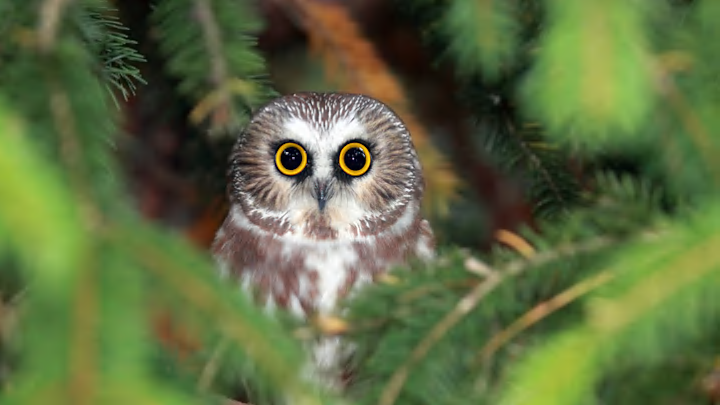If you paid a visit to the markets where Americans did their grocery shopping during the 1800s, you would see a familiar assortment of potatoes and carrots next to cuts of beef and freshly caught fish—not too different from what you’d find at a farmers’ market today. But mixed in with the meat and produce you’d also find an incredible variety of wild birds.
Depending on the season, you might see barrels of passenger pigeons, dozens of sparrows strung in rows, or exotic fare like owls or herons. The 1867 book The Market Assistant cataloged a jaw-dropping 120 species of birds sold in New York, Boston, and Philadelphia markets, which shoppers used to make favorite dishes like robin pie and plovers on toast.
To supply these markets, hunters killed so many birds that they began disappearing at an alarming rate. Concerned bird-lovers organized a response that led to Congress passing the Migratory Bird Treaty Act in 1918, which made it illegal to kill or sell most native birds, or to even own their feathers. This law has kept many birds from going the way of the passenger pigeon, but it also means you’ll never get to eat like a 19th-century American.
To give you a sense of what you’re missing out on, here are eight birds people used to have for dinner but would be a federal crime to eat today.
Robins

America’s favorite backyard bird also used to be one of its favorite dishes. In 1888 George Holden wrote that schoolboys and businessmen alike would “smack their lips when thinking of the delicious dish known as Robin pot-pie.” Wehman’s Cook Book, published two years later, included a recipe for this dish that instructed bakers to “cover the bottom of a pie-dish with thin slices of beef and fat bacon, over which lay ten or twelve robins, previously rolled in flour … and cover with three quarters of a pound of half puff paste” before baking.
Thrushes

Delmonico’s of New York City used to be the fanciest restaurant in America, and a book of its recipes from 1912 included elaborate dishes with elaborate names like Thrush Pudding, Croustades of Thrushes, and Cases of Thrushes à la Diana. The recipe for Thrushes Andrieux called for stuffing eight of the shy, robin-sized birds with ground meat and herbs, placing them in a baking dish with cubes of carrots, onions, and veal, and baking in Madeira wine before topping the birds with truffles and “escalops of cooked duck’s liver.”
Loons

The state bird of Minnesota had a reputation for being pretty unappetizing. The painter and ornithologist John James Audubon tried loons and wasn’t a fan, calling them “not very palatable,” with their meat “being tough, rank, and dark coloured.” But foodies of his day didn’t seem to mind. When he was traveling in New England, Audubon saw that loons were “much relished by many lovers of good-living, especially at Boston, where it was not infrequently served almost raw.”
Woodpeckers

Even though woodpeckers were a popular dish, Audubon again left a negative review: He found their meat “very disagreeable, it having a strong flavour of ants.” Despite their sour taste, the birds were common to find in markets. Chefs would sometimes throw a few woodpeckers into a pot pie with blackbirds or grackles, which would hopefully mask their anty essence.
Cedar Waxwings

Cedar Waxwings are sleek, knightly little birds that love moving around in friendly flocks and munching on berries. People also used to love munching on them, even though each bird, weighing only one ounce, made for just “a morsel of delicate eating.” An acquaintance of Audubon’s once shipped a basket of cedar waxwings to a friend in New Orleans as a Christmas present, only to find that “the steward of the steamer, in which they were shipped, made pies of them for the benefit of the passengers.”
Bobolinks

These handsome black- and cream-colored birds, about the size of cardinals, were a menace to Southern rice farmers. But after gorging themselves on the farmers’ crops, they became “extremely tender and juicy,” which turned them into a delicacy. You could buy a few dozen bobolinks and make a recipe from Miss Leslie’s New Cookery Book for “Birds with Mushrooms,” which called for stuffing a button mushroom in each bird, then stewing the lot in butter and serving them on toast.
Owls

Even if they hadn’t been granted federal protection in 1972 (they were excluded from the Migratory Bird Treaty Act in 1918 because they were branded as chicken thieves), few people would think about owls as food. But back in the 1800s, they were a common sight in markets. People also ate them out of necessity. Enslaved Africans in the South were often only able to hunt for food at night, which meant eating nocturnal animals like owls. And of all the birds he tasted, there’s only one that Audubon compared to the bird we eat most often today. Meat from snowy owls, he wrote, is like “that of a chicken, and not indelicate eating.”
Sparrows

You might think sparrows were too small to be worth eating, but you’d be wrong. Even though they weigh only as much as seven or eight pennies, critics called the birds “extremely delicate and juicy,” and it was easy to find small strings of the birds for sale. While America’s native species of sparrows (like the one above) are now protected by law, the invasive house sparrows brought over from Europe are not. In 1910 the U.S. Department of Agriculture suggested that people eat the “palatable and nutritious” birds to help get rid of them—which would still technically be legal today.
Read More Stories About Birds:
